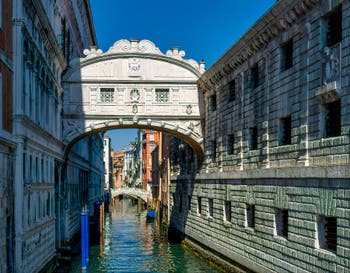The Bridges of Venice in Italy
Whether it is the Bridge of Rialto or the Bridge of Sighs, Venice is also as famous for its bridges as for its gondolas, palaces and churches: with over 400 bridges in such a small area!Visits Doge's | St.Mark | Gourmets | Museums | Venice | Murano Burano | Gondola | Cruises

The Bridge of SighsInitially, there were no actual bridges in Venice.
At best, there were wooden footbridges without steps whose construction and maintenance were the responsibility of the neighbours.
During this era, many in Venice moved about on horseback.
Then the transportation of goods and people was predominantly made by boat; the result was the beginning of actual bridge construction.
Bridges were rounded, and high enough so small boats and gondolas could pass underneath.
But at the same time, bridges become more arched with steps not adapted to the horses.
The horses were displaced and subsequently disappeared as means of transportation in the heart of Venice.
Venetians initially built the houses along the calli (streets) and of the Rii (canals) before being concerned with bridges to join the various islands which form Venice.
You can see in Venice the consequence of this reversed order, to see bridges which seem to be "sideways", almost "tossed" diagonally to connect two streets over the canal.
And with good reason, since these bridges were constructed afterwards while trying to adapt to the configuration of the existing calli (streets).
Small, large, plump, straight or from side to side, stone, wooden and metal, decorated and sculpted or even simple, the diversity of Venice’s bridges adds to the city’s beauty and its very romantic aspect.
Besides, a significant part of the city’s history can be shown there.
If they began constructing stony bridges only in the XIVth century, the bridges constructed entirely out of metal came after 1800 and are essentially bridges built by the Austrians at the time of their occupation of Venice.
Another detail of significance: the bridges of Venice originally had no parapets.
The parapets you see were added long after their building to prevent too many people from falling into the water!
This type of accident was so common that Il Gazzetinno, the newspaper of Venice, had a daily chart listing the names of people who had fallen into the water the previous day.
There is one remaining bridge in Venice without parapets; it is in the Cannaregio district and spans over the San Felice Canal: The Chiodo Bridge.
It is also necessary that you know that the bridges of Venice are also places of life.
If you notice, you will see that day and night; people stop atop bridges to rest, look at water, smoke cigarettes, and speak to each other as if they were better up high.
We even lived just beside a bridge in Venice, and all day and night, we could note these behaviours of stopping atop the bridges. For this reason, we will share a small amusing anecdote.
Every night, at about 10 pm, a Venetian of about sixty years old came home after having drunk too many glasses of ombra (wine).
And systematically, he stopped at the top of our bridge, faced the Rio (canal) and ranted loudly for a good dozen minutes.
The echo of his voice, amplified by water and facades of houses, undoubtedly delighted him. Then, extremely satisfied, he went home only to begin again the next night!
Back to Top of Page

